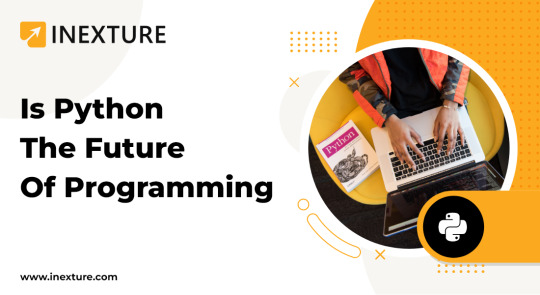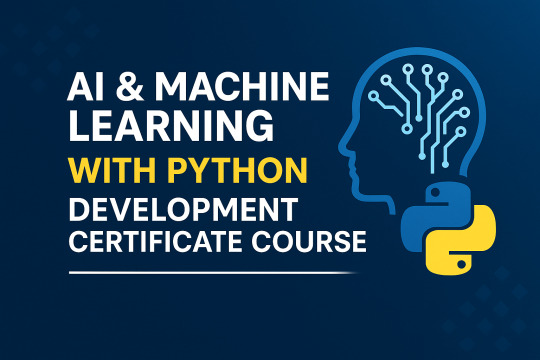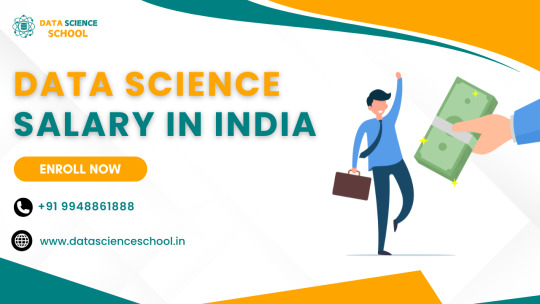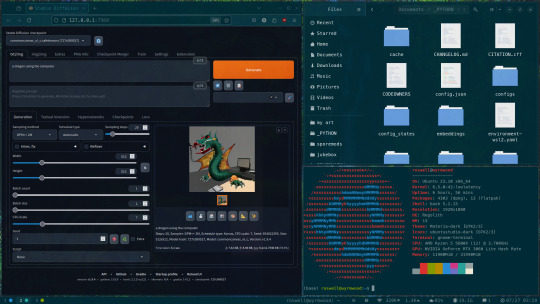#Python AI future
Explore tagged Tumblr posts
Text
Is Python the Future of Programming?

Enter the thrilling world of software development, where unlimited options abound and creativity abounds. Python, a powerful tool that has captured the attention of developers worldwide, has sparked a new era of coding brilliance in the ever-changing digital landscape.
Python development is a versatile and strong programming language that is reshaping the programming landscape. Python, with its versatility, scalability, and endless potential, is unstoppable, attracting programmers and moving us toward an awesome future.
Prepare for an exciting voyage as we investigate why Python is destined to be the driving force behind technological developments in the future. So strap on and get ready for a trip that unveils the true essence of Python’s importance and the incredible things it can help us do.
Python has become famous because it has some really great features.
Python’s quick climb to prominence can be attributed to its unique features that distinguish it from other programming languages. Its simple syntax, extensive library ecosystem, adaptability, and emphasis on readability have made it a favorite among developers all around the world. Python’s popularity is likely to skyrocket as it continues to expand and adapt to new trends, solidifying its status as one of the most significant programming languages of our time.
Here are some of the key factors that have contributed to Python’s fame:
Clean and Clear Syntax: Python’s syntax is intended to be straightforward and easy to grasp. It defines code chunks with indentation, which increases readability and ensures consistent formatting. This eliminates the need for superfluous brackets or semicolons, decreasing visual clutter and making the code more visually pleasing.
File and Directory Operations: The os module contains utilities for interacting with files, directories, and the operating system. It lets you alter paths, create and delete folders, conduct file I/O operations, and do other things.
Data Analysis and Scientific Computing: Python Development has grown in popularity as a data analysis and scientific computing language, owing mostly to modules such as NumPy, Pandas, and SciPy. NumPy delivers robust numerical processing capabilities, Pandas provides high-performance data manipulation and analysis tools, and SciPy offers a diverse set of scientific and engineering tasks. Python has become the go-to language for data scientists and academics thanks to these libraries and visualization tools like Matplotlib and Seaborn.
Machine Learning and Artificial Intelligence: Python’s environment places a strong emphasis on machine learning and artificial intelligence. TensorFlow, Keras, PyTorch, and sci-kit-learn libraries provide solid frameworks for constructing and deploying machine learning models. These libraries provide a diverse set of algorithms, tools for model training and evaluation, and deep learning support. Python’s expressive syntax and simplicity make it an ideal language for developing machine learning algorithms and working with enormous datasets.
C/C++ Integration: Python provides interfaces and tools to easily integrate with C and C++ code. Developers can write extensions in C or C++ and use them in Python programs using Python’s C API or third-party libraries like Cython or ctypes.
Frameworks and APIs: Python’s extensibility is improved further by the availability of frameworks and APIs that allow developers to extend current functionality. Django, Flask, and TensorFlow, for example, provide a basis for constructing web apps, APIs, and machine learning models.

Examining the Statistics: The Popularity of Python
Python has just recently established itself as one of the most popular programming languages.
Statistical data consistently support the claim of Python’s popularity.
Python consistently ranks among the top programming languages in terms of popularity, adoption, and community engagement.
The TIOBE Index consistently places Python in the top three positions based on search engine queries and other factors.
The PYPL Index consistently ranks Python as the most popular language based on tutorial searches on Google.
Stack Overflow’s annual Developer Survey consistently reveals Python as one of the most commonly used languages among professional developers.
These statistics provide concrete evidence of Python’s widespread adoption.
Python appeals to a diverse range of developers, from beginners to seasoned professionals.
Advantages and Strengths of Python
Clear and Readable Syntax: Python’s syntax is intended to be highly readable and simple. It delimits code blocks with indentation and whitespace, making the code structure visually beautiful and easy to read. Python also avoids using complex symbols and superfluous punctuation, yielding code that closely resembles natural English. This clarity improves Python code readability and minimizes the likelihood of errors or confusion.
Easy to Learn and Understand: Python’s ease of use makes it an excellent language for novices. The straightforward and accessible syntax lowers the barrier to entry, making it easier for newbies to grasp programming ideas. Python’s emphasis on simplicity, paired with its vast documentation and helpful community, provides a gentle learning curve for beginners.
Continuous Development: Python’s community is continually working to improve and evolve the language. Python is developed and maintained by the Python Software Foundation (PSF), a non-profit organization. Python receives regular updates and new versions to address issues, bring new features, and improve efficiency. Developers regularly participate in debates and contribute to the Python Enhancement Proposal (PEP) process, and community feedback is critical in influencing the language’s future.
Events and Conferences: The Python community organizes a plethora of events, conferences, and meetups all over the world. These events allow developers to network, learn from professionals, and remain up to date on the newest advancements in the Python ecosystem. PyCon brings together Python fans from all backgrounds to create a venue for information sharing, collaboration, and community building.
Is Python the future of programming
Python is unquestionably positioned to be one of the main programming languages in the near future.
Its versatility, simplicity, and large library have made it popular among developers in a variety of fields.
Python’s diverse set of applications, ranging from web development to data analysis to machine learning and artificial intelligence, contributes to its expanding popularity.
Furthermore, its big and active community is constantly improving the language, making it more powerful and user-friendly.
Python’s significant presence in developing technologies, as well as its emphasis on readability and productivity, make it an appealing choice for both novices and experienced programmers, implying a promising future.
Conclusion
Python is an excellent choice for developers working in a variety of fields. Its lively and energetic community constantly improves the language, assuring its continued growth and progress.
Python’s strong presence in evolving technologies, as well as its emphasis on readability and productivity, make it an appealing choice for both new and experienced programmers. Python, with its boundless potential and ongoing innovation, is set to impact the future of programming and drive technological progress.
Originally published by: Is Python the Future of Programming?
#Python programming#future of programming#Python applications#Programming language#Python AI future#Python development
0 notes
Text
How learning best python skill can transform your career in 2025

In 2025, tech skills are evolving faster than ever — and Python has become the top programming language powering the future of artificial intelligence and machine learning. Whether you're a beginner or looking to upskill, learning Python for AI and ML could be the career move that sets you apart in this competitive job market.
Key benefits of learning python for AI & ML in 2025
Future-Proof Skill
As automation and AI become integral to every industry, Python fluency gives you a competitive edge in an AI-first world.
Beginner-Friendly Yet Powerful
You don’t need a computer science degree to learn Python. It’s perfect for non-tech professionals transitioning into tech careers.
Freelance and Remote Opportunities
Python developers working in AI and ML are in high demand on platforms like Upwork and Toptal many command salaries above six figures, working remotely.
Community and Resources
With massive open-source support, free tutorials, and active forums, you can learn Python for AI even without formal education.
Create roadmap: python for Ai and Machine learning
Master the Basics Start with variables, data types, loops, functions, and object-oriented programming in Python.
Understand Data Science Foundations Learn to work with Pandas, NumPy, and Matplotlib for data preprocessing and visualization.
Dive into Machine Learning Explore supervised and unsupervised learning using Scikit-learn, then graduate to TensorFlow and PyTorch for deep learning.
Build Real Projects Hands-on experience is key. Start building real-world applications like:
Spam email classifier
Stock price predictor
Chatbot using NLP
Why python is the best language for AI & Machine learning
Python's simplicity, vast libraries, and flexibility make it the best programming language for artificial intelligence. With intuitive syntax and community support, it's a favorite among data scientists, developers, and AI engineers.
✅ High-demand Python libraries in AI:
TensorFlow and Keras – deep learning models
Scikit-learn – machine learning algorithms
Pandas & NumPy – data analysis and manipulation
Matplotlib & Seaborn – data visualization
These tools allow developers to build everything from predictive models to smart recommendation systems all using Python.
Career Opportunities After Learning Python for AI
If you're wondering how Python for AI and ML can shape your future, consider this: tech companies, startups, and even non-tech industries are hiring for roles like:
Machine Learning Engineer
AI Developer
Data Scientist
Python Automation Engineer
NLP (Natural Language Processing) Specialist
According to LinkedIn and Glassdoor, these roles are not just high-paying but are also projected to grow rapidly through 2030.
Best courses to learn python for Ai & ML in 2025
Google AI with Python (Free course on Coursera)
Python course With SKILL BABU
IBM Applied AI Certification
Udemy: Python for Machine Learning & Data Science
Fast.ai Deep Learning Courses (Free)
These programs offer certifications that can boost your resume and help you stand out to employers.
Conclusion: Choose Your Best Career with Python in 2025
If you’re looking to stay ahead in 2025’s job market, learning Python for AI and machine learning is more than a smart move , it’s a career game-changer. With endless growth opportunities, high-paying roles, and the chance to work on cutting-edge technology, Python opens doors to a future-proof tech career.
Start today. The future is written in Python.
#python#app development company#PythonForAI#MachineLearning2025#LearnPython#TechCareers#AIin2025#Python Programming#Learn AI in 2025#Machine Learning Career#Future Tech Skills#Python for Beginners
0 notes
Text
Navigate the AI revolution! Discover essential computer skills – from Python to data literacy – you need to thrive in the future tech landscape. Learn how to stay relevant.
#Computer classes in Iskcon-Ambli Road#computer skills for AI#Future Tech Skills#Python programming courses in Ahmedabad#TCCI - Tririd Computer Coaching Institute
0 notes
Text
Prompt: - Two thick lines playing tennis. Camera view from above.
by Claude 4 Sonnet Conclusion: of course it's a very simplistic pyhton algorithm. I could make it much more sophisticated. But can you imagine the possibilities? AI, quantum computing are much bigger than the internet itself. They are creating new worlds, realities, unimaginable things and every single person will program the future.
0 notes
Text
Dockit Migrator: Effortless SharePoint Migration Solution

Introduction
Many users find Moving SharePoint data between platforms a major and complex operation. SharePoint Online (Office 365) and SharePoint version updates require complicated, time-intensive procedures. During the process, a large number of data items, custom workflows, and permissions need to be correctly transferred.
Dockit Migrator provides the ideal solution for many different use case scenarios. The features of this tool aim to simplify SharePoint migration and related processes while reducing time and workload. Vyapin also offers other similar solutions at an affordable price. Dockit Migrator manages all migration sizes from small to large enterprise operations without introducing unwanted complexities.
What is Dockit Migrator?
Dockit Migrator provides users a solution to transfer content between different SharePoint environments containing documents and lists with additional information between various SharePoint deployments. Dockit Migrator serves as a tool to transfer data between local File Shares, SharePoint deployments and SharePoint Online platform (Microsoft 365) and helps users to move between different SharePoint versions (like when users upgrade from SharePoint 2016 to SharePoint 2019).
Dockit Migrator provides an easy-to-use user interface that allows even migration staff without much technical background to move SharePoint content with ease. Through its intuitive interface, users can handle complex migration processes that will otherwise take longer times to complete, thanks to Dockit Migrator's advanced functions and features.
Why Choose Dockit Migrator?
Many organizations, such as those in Healthcare, Legal and Manufacturing, rely on SharePoint Migration tools like the Dockit Migrator for their SharePoint migration because of its numerous powerful features. The main features of Dockit Migrator include the following:
1. Dockit Migrator Moves All Content along With their Permission
Dockit Migrator serves as a complete file transfer solution that handles documents along with other associated elements. The software enables the complete movement of SharePoint sites alongside their lists and libraries together with metadata and permission elements. The functionality of the Dockit Migrator includes the correct transfer of all content along with custom workflows and user settings.
2. Before Migration Occurs: Perform an Ahead-of-Time Success Evaluation
The pre-migration assessment from Dockit Migrator runs its tests before any migration procedures begin. Dockit Migrator performs a pre-migration evaluation that uncovers potential issues that could affect the migration process later on. Using this tool enables you to prevent unexpected outcomes during the migration process by ensuring it completes without difficulties.
3. Incremental Migration to save time
Mass data transfers usually take up extensive amounts of time when performed in a single operation. Dockit Migrator allows incremental data migrations that transfer only changed or selected content and updated metadata during successive phases of the migration process. The feature enables you to move only the essential data so you can cut down on lengthy migrations.
4. Easy to Use, Even for Non-Experts
Dockit Migrator simplifies the process of migrating complex SharePoint data assortments. Dockit Migrator delivers an interface that allows users without technical expertise to handle their migration process. The wizard takes you step-by-step through the process smoothly. Even without SharePoint expertise, you can easily execute the migration work. Vyapin Software's Dockit Migrator simplifies the process of migrating complex SharePoint data assortments, making it accessible for all users.
5. The Software Preserves Both Permission Structures and other Security configuration details Throughout Your Migration Process
The most challenging aspect of any SharePoint migration tool or its processes involves preserving user permission structures together with other security configurations. With its secure permission and security settings migration technique, Dockit Migrator ensures smooth transition to your new SharePoint environment. Users can maintain content accessibility throughout the migration with no disruptions.
7. Supports Multiple SharePoint Versions
In addition to SharePoint 2007 and 2013, the product supports migration to versions 2016, 2019, and SharePoint Online. The product boasts excellent versatility to suit businesses that handle SharePoint data movement between various SharePoint platforms.
The user-friendly features of Dockit Migrator provide efficiency in your daily or routine SharePoint migration activities while remaining a non-disruptive process for your organization. Your SharePoint migration process becomes effortless with Dockit Migrator, which provides a robust solution that manages complete content movement along with security configurations and role permissions.
Your SharePoint migration benefits from Dockit Migrator's user-friendly design, which includes pre-migration analyses along with step-by-step document transfer options to streamline your process and minimize problems encountered in typical projects.

Conclusion
With Dockit Migrator, the process of moving SharePoint content remains straightforward and uncomplicated. This SharePoint Migration tool from Vyapin provides extensive functionality, alongside a user-friendly UI and reliable customer support for your SharePoint Online migration projects.
To conclude, Vyapin and its SharePoint Migration tool enable you to concentrate on business objectives because it manages complex migration scenarios. Your migration process will also become more efficient using DocKIT migrator’s SharePoint migration planning features, which reduces the overall time and effort in the whole process.
#Technology#Tech News#Latest Tech#Future Tech#Innovation#Tech Trends#Digital Transformation#Software Development#Programming#Coding#Web Development#App Development#Frontend#Backend#Full Stack#JavaScript#Python#AI Development#Gadgets#Smartphones#Wearables#Smart Home#Tech Reviews#Device Comparison#Artificial Intelligence#Machine Learning#Robotics#Blockchain#Augmented Reality#Virtual Reality
1 note
·
View note
Text
Data Science Salary In India

Data science in India is experiencing a tremendous boom, driven by advancements in artificial intelligence (AI), big data, and analytics. This dynamic field is transforming business decision-making processes by optimizing operations, predicting trends, and enhancing customer experiences across industries. India has emerged as a global hub for data science, accounting for 11% of worldwide data science jobs. Hiring is on the rise, with opportunities flourishing in both startups and large corporations.
The compensation in the field is equally impressive. Entry-level professionals can expect salaries ranging from ₹4 to ₹8 LPA, while mid-level experts earn between ₹10 to ₹15 LPA. Senior roles command ₹20 to ₹40 LPA, with specialized skills pushing these figures higher. Among top cities, Bangalore leads with an average salary range of ₹12 to ₹15 LPA, followed by Mumbai and Hyderabad at ₹10 to ₹15 LPA and ₹10 to ₹12 LPA, respectively.
To excel in this field, aspiring data scientists must master programming languages like Python, develop expertise in machine learning, and become proficient in tools like Tableau. Additionally, soft skills such as problem-solving and effective communication are critical for success. Emerging trends, such as roles in AI ethics and quantum analytics, further underscore the evolving nature of the domain. By 2025, the demand for data science professionals in India is projected to reach 1.5 million jobs.
The growth potential in this field is staggering, with salaries expected to rise significantly, ranging from ₹8 to ₹50 LPA depending on experience and specialization. For those considering a career in data science, the journey begins with entry-level roles offering ₹4 to ₹8 LPA. The IT, BFSI, and e-commerce sectors currently lead in hiring, and the future holds immense promise, with rapid demand and salary growth anticipated in the years to come.
Introduction
Data science is one of the most transformative fields of the 21st century, reshaping industries and redefining how businesses make decisions. India, with its rapidly growing technology landscape, has emerged as a hub for data science professionals. From startups to multinational corporations, the demand for data science expertise has skyrocketed, making it a highly lucrative career option. This article delves deep into the world of data science in India, exploring salaries, key skills, top-paying industries, and future trends.
Overview of Data Science in India
Data science combines statistical techniques, machine learning algorithms, and data visualization to extract insights from raw data. In India, this field has gained prominence due to the digital transformation across industries. Businesses are leveraging data science to improve efficiency, predict customer behavior, and gain a competitive edge.
The rise of data science in India can be attributed to factors such as the proliferation of digital data, advancements in computing power, and a growing emphasis on data-driven decision-making. Moreover, the availability of talent and cost-effective solutions has positioned India as a preferred destination for global firms seeking data science expertise.
Importance of Data Science in Modern Businesses
In today's digital age, data is often referred to as the "new oil." Businesses generate vast amounts of data daily, and harnessing this data effectively can unlock immense value. Data science plays a pivotal role in helping businesses make informed decisions, optimize processes, and enhance customer experiences.
For instance, retail companies use data science to predict inventory requirements, while financial institutions employ it for fraud detection. Healthcare organizations rely on data science for predictive diagnostics and treatment planning. This widespread application underscores the importance of data science in shaping the future of modern businesses.
Growing Demand for Data Scientists in India
The demand for skilled data scientists in India has grown exponentially in recent years. According to industry reports, India accounts for 11% of the global demand for data science roles, ranking among the top countries for data science hiring. Factors contributing to this demand include the adoption of AI and machine learning, the rise of analytics-driven startups, and the push for digital transformation across sectors.
Additionally, Indian companies are investing heavily in building in-house data science capabilities, further driving demand for professionals in this domain. With competitive salaries and diverse career opportunities, data science has become a sought-after field for aspirants in India.
Understanding the Role of Data Science
Data science encompasses a wide range of functions, from data collection and cleaning to advanced analytics and predictive modeling. At its core, it involves turning raw data into actionable insights that drive strategic decision-making.
Data scientists often work in interdisciplinary teams, collaborating with business leaders, software engineers, and domain experts. They are responsible for identifying patterns, solving complex problems, and designing algorithms that provide accurate predictions. This multifaceted role requires not only technical expertise but also a deep understanding of the business context.
What Do Data Scientists Do?
Data scientists wear many hats, making their role both dynamic and essential in modern organizations. At a high level, data scientists analyze large datasets to uncover trends, patterns, and actionable insights that help organizations achieve their goals. But their day-to-day responsibilities are far more intricate.
Data Collection and Cleaning: A significant portion of a data scientist's time is spent gathering data from various sources and ensuring its accuracy. Raw data is often messy and requires cleaning to make it usable for analysis.
Exploratory Data Analysis (EDA): EDA involves diving deep into the data to identify key patterns, correlations, and anomalies. This step helps data scientists understand the dataset and formulate hypotheses for further testing.
Model Building and Testing: Using machine learning algorithms, data scientists develop predictive models tailored to the business problem. They fine-tune these models to achieve optimal accuracy and performance.
Data Visualization and Communication: Presenting complex findings in an understandable manner is a crucial skill. Data scientists create dashboards, graphs, and reports to communicate their insights effectively to stakeholders.
Their role is continuously evolving, incorporating advancements in AI, natural language processing, and real-time analytics to address ever-changing business needs.
Key Skills Required for a Data Scientist
To excel as a data scientist, one must possess a blend of technical, analytical, and interpersonal skills. Here’s a breakdown of the essential skills:
Technical Skills:
Programming Languages: Proficiency in Python and R is fundamental for data manipulation and analysis.
Statistical Knowledge: A strong grasp of probability, regression, and hypothesis testing is crucial for building models.
Machine Learning: Familiarity with algorithms like decision trees, random forests, and neural networks is vital.
Data Handling Tools:
Mastery of SQL for database querying.
Experience with data visualization tools like Tableau, Power BI, or Matplotlib.
Soft Skills:
Communication: Simplifying complex data for non-technical stakeholders.
Problem-Solving: Addressing real-world challenges through innovative solutions.
Critical Thinking: Evaluating data objectively to make sound decisions.
Continuous learning and adapting to new technologies are equally important as the field evolves rapidly.
Industries Hiring Data Scientists
Data science is a versatile field, finding applications across nearly every industry. Some of the top sectors hiring data scientists in India include:
IT and Software Development: Companies leverage data science for application performance monitoring, cybersecurity, and improving user experiences.
E-commerce: Platforms like Amazon and Flipkart use data science for personalized recommendations, inventory management, and fraud detection.
Healthcare: Data science aids in predictive diagnostics, drug development, and optimizing hospital operations.
Banking and Financial Services: It plays a pivotal role in risk assessment, fraud detection, and customer segmentation.
Manufacturing: Predictive maintenance and supply chain optimization are key areas where data science adds value.
The growing adoption of AI, IoT, and big data analytics ensures that demand for data scientists will remain strong across sectors.
Data Science Salary Structure in India
Data science is among the highest-paying careers in India, with salaries varying based on experience, industry, and geographic location. Here’s a detailed look at the salary structure:
Entry-Level: Fresh graduates can expect an annual package of ₹4–6 lakh. With certifications and internships, this figure can rise to ₹8 lakh.
Mid-Level: Professionals with 3–5 years of experience earn between ₹10–15 lakh per annum, reflecting their expertise and specialization.
Senior-Level: Experienced data scientists with over 7 years in the field command salaries upwards of ₹20 lakh, often exceeding ₹30 lakh in top-tier companies.
The salary structure reflects the value organizations place on data-driven insights, making this field highly rewarding financially.
Average Salary of a Data Scientist in India
The average salary of a data scientist in India hovers around ₹10 lakh per annum. However, this figure varies significantly based on factors like the organization, job role, and location. For example, startups may offer slightly lower packages than established tech giants, but they compensate with perks like equity.
Tech hubs like Bangalore and Hyderabad often offer above-average salaries due to the concentration of IT companies and demand for talent. Furthermore, niche roles like AI specialists or machine learning engineers typically command higher salaries compared to generalist roles.
Entry-Level Data Scientist Salary
An entry-level data scientist typically has limited professional experience but possesses foundational skills in data analysis, programming, and machine learning. In India, entry-level salaries for data scientists range from ₹4 to ₹8 lakh per annum, depending on factors such as educational background, certifications, and the hiring organization.
Factors Influencing Entry-Level Salaries:
Educational Qualifications: Graduates from top institutions like IITs or those holding advanced degrees in data science often secure higher starting salaries.
Certifications: Credentials in machine learning, big data, or data visualization can provide an edge.
Internships: Practical experience gained through internships significantly boosts employability and salary prospects.
Entry-level roles typically involve tasks like data cleaning, exploratory analysis, and supporting senior team members in model development. As individuals gain experience and take on more responsibilities, they can expect substantial salary hikes.
Mid-Level Data Scientist Salary
Mid-level data scientists are those with 3–5 years of experience, capable of handling complex projects independently. Their annual salary ranges between ₹10–15 lakh, with some roles reaching ₹18 lakh in tech-centric cities like Bangalore and Gurgaon.
Key Responsibilities at This Level:
Leading end-to-end analytics projects.
Designing and deploying machine learning models.
Mentoring junior team members and collaborating with cross-functional teams.
Mid-level professionals often have a specialization, such as natural language processing (NLP) or deep learning, which adds to their market value. Companies in competitive industries like fintech and e-commerce tend to offer higher salaries for these positions.
Senior-Level Data Scientist Salary
Senior-level data scientists, with over 7 years of experience, are among the most sought-after professionals in India. Their expertise, combined with their ability to drive business strategies through data insights, commands salaries upward of ₹20 lakh, often reaching ₹40 lakh or more in leading organizations.
What Sets Senior-Level Data Scientists Apart:
Strategic Influence: Senior professionals guide the organization’s data strategy, ensuring alignment with business goals.
Technical Expertise: They are skilled in advanced techniques like deep learning, real-time analytics, and AI deployment.
Leadership Skills: Many take on managerial roles, overseeing teams and mentoring upcoming talent.
Top-tier firms and multinational corporations are willing to offer premium packages to attract experienced talent, reflecting the critical role of senior data scientists in shaping business outcomes.
Factors Influencing Data Science Salaries
Several factors impact the earning potential of data scientists in India. Understanding these elements can help professionals strategize their career growth:
Educational Background: Advanced degrees and specializations in data science, computer science, or related fields often lead to higher salaries.
Certifications: Industry-recognized certifications like Microsoft Certified Data Scientist, Google Data Analytics, or SAS certifications can significantly boost earning potential.
Industry: Salaries vary by sector, with IT, finance, and e-commerce offering higher packages compared to traditional industries.
Geographic Location: Tech hubs like Bangalore and Hyderabad offer higher salaries compared to smaller cities due to higher demand for skilled professionals.
Experience: As professionals climb the experience ladder, their salaries increase correspondingly, reflecting their growing expertise and value to organizations.
Impact of Education on Salaries
Education plays a pivotal role in shaping a data scientist’s career trajectory and earning potential. Here’s how:
Graduate and Postgraduate Degrees: A bachelor’s degree in a related field is the minimum requirement, but postgraduate degrees, such as a Master’s in Data Science or Analytics, can open doors to higher-paying roles.
Institution Reputation: Graduates from top-tier institutions like the IITs, IIMs, or ISB are often preferred by recruiters and can negotiate higher starting salaries.
Continuous Learning: Short-term courses and certifications from platforms like Coursera, edX, and Udemy keep professionals updated and competitive in a rapidly evolving field.
Employers value a combination of formal education and practical experience, making internships and project-based learning integral for aspiring data scientists.
Relevance of Certifications
Certifications have become an essential aspect of a data scientist's career progression. They validate specialized skills and provide a competitive edge in the job market. Recruiters often prioritize candidates with certifications in emerging technologies and methodologies relevant to data science.
Top Certifications for Data Scientists in India:
Google Data Analytics Certification: A beginner-friendly course that covers essential data analysis skills.
IBM Data Science Professional Certificate: Offers hands-on learning in Python, machine learning, and data visualization.
AWS Certified Machine Learning – Specialty: Focused on cloud-based machine learning applications.
Certified Analytics Professional (CAP): Validates expertise in end-to-end analytics processes.
Certifications not only enhance employability but also boost earning potential. Many organizations view them as proof of commitment to professional development, making certified professionals eligible for higher salaries.
Influence of Industry Type on Salaries
The industry in which a data scientist works significantly affects their earning potential. While demand for data scientists spans almost every sector, some industries offer higher compensation due to the criticality of their data-driven operations.
IT and Software:
Data science roles in IT often involve building AI-driven applications, leading to higher pay scales.
Salaries range from ₹8–25 lakh per annum, depending on experience.
Banking and Finance:
Financial institutions use data science for risk analysis, fraud detection, and customer segmentation, making these roles highly valuable.
Salaries are comparable to or higher than IT roles, ranging from ₹10–30 lakh annually.
Healthcare and Pharmaceuticals:
Predictive diagnostics and personalizd medicine are driving demand for data scientists.
Salaries range from ₹7–20 lakh, with potential for rapid growth.
Other high-paying industries include e-commerce, telecommunications, and media, where data-driven strategies directly impact business performance.
Geographic Location and Salary Variation
In India, a data scientist’s salary can vary widely based on the geographic location of their employment. Cities with a robust tech infrastructure and higher living costs tend to offer higher pay packages.
Bangalore: Known as India’s Silicon Valley, Bangalore offers the highest average salaries for data scientists, often 15–20% higher than the national average.
Hyderabad: A hub for IT and pharmaceutical companies, Hyderabad offers competitive salaries, especially for mid- and senior-level roles.
Mumbai: Financial institutions in Mumbai drive demand for data science professionals, leading to high pay scales in the financial sector.
Delhi-NCR: A blend of startups and established firms in this region creates diverse opportunities with competitive salaries.
Chennai: Known for its manufacturing and IT sectors, Chennai offers steady demand and growth prospects for data scientists.
Relocation to these cities can be a strategic move for professionals aiming for higher salaries and better career opportunities.
Experience and its Role in Salary Hikes
Experience is one of the most significant factors influencing a data scientist’s earning potential. As professionals gain hands-on expertise, their value in the job market increases, leading to substantial salary growth.
Early Career (0–3 Years):
Responsibilities include basic data analysis and support tasks.
Salaries range from ₹4–8 lakh per annum.
Mid-Career (3–7 Years):
Professionals take on complex projects and mentor junior staff.
Salaries range from ₹10–20 lakh per annum.
Senior-Level (7+ Years):
Responsibilities expand to strategic decision-making and leading data initiatives.
Salaries often exceed ₹30 lakh annually in top firms.
Experience also enhances domain knowledge and soft skills, which are critical for leadership roles and further salary hikes.
Data Science Salaries by Job Roles
The field of data science encompasses various specialized roles, each with distinct responsibilities and salary ranges.
Data Analysts:
Focus on interpreting and visualizing data to aid decision-making.
Average salary: ₹5–8 lakh per annum.
Machine Learning Engineers:
Design and deploy machine learning algorithms.
Average salary: ₹8–18 lakh per annum.
Data Engineers:
Build and maintain the infrastructure for data collection and storage.
Average salary: ₹7–15 lakh per annum.
AI Specialists:
Work on cutting-edge AI technologies like deep learning and NLP.
Average salary: ₹12–25 lakh per annum.
Business Intelligence Analysts:
Translate data insights into business strategies.
Average salary: ₹6–10 lakh per annum.
These job roles highlight the diversity of opportunities within data science, catering to different skill sets and interests.
Salary for Data Analysts
Data analysts play a critical role in extracting meaningful insights from raw data. While their responsibilities are more focused than those of data scientists, their work is essential in supporting business decisions. In India, data analysts typically earn between ₹4–8 lakh per annum, depending on their experience and location.
Key Factors Influencing Salaries:
Technical Skills: Proficiency in SQL, Excel, and data visualization tools like Tableau or Power BI boosts earning potential.
Industry: Sectors like finance, e-commerce, and IT offer higher salaries to data analysts.
Experience: Senior analysts with 5+ years of experience can earn upwards of ₹10 lakh annually.
With opportunities to transition into advanced roles such as data scientist or business intelligence analyst, data analysts enjoy a promising career trajectory.
Salary for Machine Learning Engineers
Machine learning engineers specialize in creating algorithms and systems that allow machines to learn and improve from data. This role commands high salaries, typically ranging from ₹8–18 lakh per annum in India.
Why Do Machine Learning Engineers Earn More?
High Demand: The adoption of AI across industries drives the need for machine learning experts.
Complex Skill Set: Expertise in programming, statistics, and machine learning frameworks like TensorFlow and PyTorch makes this role highly valued.
Impact on Business: Machine learning applications often result in significant cost savings and efficiency gains for organizations.
As companies invest more in AI and automation, the demand for machine learning engineers is expected to grow, further driving salaries upward.
Salary for Data Engineers
Data engineers focus on building and maintaining the infrastructure that supports data processing and analytics. Their role is crucial for ensuring that data scientists and analysts have access to reliable and well-structured data. In India, data engineers earn between ₹7–15 lakh per annum.
What Contributes to Their Salaries?
Technical Expertise: Skills in database management, ETL tools, and cloud platforms like AWS and Azure are highly valued.
Demand for Scalable Solutions: As organizations deal with ever-growing data volumes, the need for robust data pipelines is increasing.
Cross-Functional Role: Data engineers work closely with analysts, scientists, and IT teams, making their contributions indispensable.
Experienced data engineers with a deep understanding of big data technologies can earn over ₹20 lakh annually.
Salary for AI Specialists
Artificial intelligence specialists are at the forefront of innovation, working on advanced AI technologies like deep learning, natural language processing, and robotics. These professionals command some of the highest salaries in data science, often ranging from ₹12–25 lakh per annum.
Why Are AI Specialists Highly Paid?
Cutting-Edge Skills: Mastery of advanced concepts like neural networks and reinforcement learning is rare and in high demand.
Transformational Impact: AI specialists drive innovations that redefine business processes and customer experiences.
Global Demand: With AI being a global phenomenon, Indian professionals with expertise in this domain are often sought after by international firms.
The scope for growth in this field is immense, with roles expanding into AI ethics, explainable AI, and other emerging areas.
Salary for Business Intelligence Analysts
Business intelligence (BI) analysts bridge the gap between data insights and strategic decision-making. They focus on creating reports, dashboards, and metrics that help organizations track performance and plan effectively. In India, BI analysts earn between ₹6–10 lakh per annum on average.
Factors Affecting BI Analyst Salaries:
Tool Proficiency: Expertise in BI tools like Tableau, QlikView, or Power BI is critical.
Industry-Specific Knowledge: BI analysts in finance, retail, and healthcare sectors often earn higher salaries due to the complexity of data in these domains.
Experience and Certifications: Certifications in BI tools or analytics can lead to higher pay and better roles.
BI analysts play a pivotal role in driving data-driven decision-making, making their contributions highly valued across industries.
Top-Paying Cities for Data Scientists in India
Location significantly impacts a data scientist's earning potential in India. Here are the top cities offering the best salaries:
Bangalore: Known for its thriving tech ecosystem, data scientists in Bangalore earn an average of ₹12 lakh per annum.
Mumbai: With a strong financial sector, Mumbai offers lucrative opportunities, with salaries ranging from ₹10–15 lakh.
Hyderabad: A hub for IT and pharmaceuticals, Hyderabad provides competitive salaries averaging ₹10–12 lakh annually.
Delhi-NCR: The blend of startups and established firms results in an average salary of ₹9–12 lakh for data scientists.
Chennai: Known for its IT and manufacturing sectors, Chennai offers salaries averaging ₹8–10 lakh per annum.
Relocating to these cities can be a strategic decision for professionals seeking higher pay and better growth opportunities.
Data Science Salaries in Bangalore:
Bangalore, often referred to as India’s Silicon Valley, is the top destination for data science professionals in the country. With a thriving IT ecosystem and a concentration of multinational corporations, Bangalore offers some of the highest salaries for data scientists.
Average Salaries by Experience Level:
Entry-Level: ₹6–8 lakh per annum.
Mid-Level: ₹12–18 lakh per annum.
Senior-Level: ₹20–40 lakh per annum.
Key Factors Driving High Salaries:
Tech-Driven Ecosystem: Home to global IT giants like Infosys, Wipro, and Amazon.
Startups and Unicorns: Companies like Flipkart and Swiggy actively hire data scientists, driving demand.
Networking Opportunities: Bangalore hosts numerous tech meetups, conferences, and hackathons that help professionals enhance their careers.
The city’s reputation as a tech hub makes it a hotspot for data science roles, with salaries often 20–30% higher than the national average.
Data Science Salaries in Mumbai:
Mumbai, India’s financial capital, is a prime location for data science professionals, particularly those in the banking, financial services, and insurance (BFSI) sector. Data science roles here are lucrative, given the critical nature of data in finance and business.
Average Salaries by Experience Level:
Entry-Level: ₹5–7 lakh per annum.
Mid-Level: ₹10–15 lakh per annum.
Senior-Level: ₹20–35 lakh per annum.
Why Mumbai Stands Out:
BFSI Dominance: Institutions like HDFC Bank, ICICI Bank, and JP Morgan leverage data science for fraud detection, risk assessment, and customer segmentation.
Corporate Headquarters: Many top companies are headquartered in Mumbai, increasing demand for skilled professionals.
Diverse Opportunities: Apart from BFSI, media and entertainment companies also require data science expertise.
Mumbai offers competitive salaries, particularly for those looking to specialize in finance or media analytics.
Data Science Salaries in Hyderabad:
Hyderabad has rapidly evolved into a hub for data science and analytics, driven by its strong IT infrastructure and growing pharmaceutical sector. With companies like Microsoft and Novartis having a significant presence, the city provides ample opportunities for data science professionals.
Average Salaries by Experience Level:
Entry-Level: ₹5–7 lakh per annum.
Mid-Level: ₹10–14 lakh per annum.
Senior-Level: ₹18–30 lakh per annum.
Industries Driving Demand:
IT and Tech: Companies like Google and Facebook are major recruiters.
Pharmaceuticals: Firms like Dr. Reddy’s and Aurobindo Pharma utilize data science for drug research and market analytics.
Startups: The startup ecosystem in Hyderabad offers exciting roles for data scientists, especially in AI and machine learning.
Hyderabad's cost of living is also lower than Bangalore and Mumbai, making it an attractive destination for professionals.
Data Science Salaries in Delhi-NCR:
The Delhi-NCR region is a growing hub for data science, fueled by its diverse industries and proximity to government organizations. The area offers competitive salaries and a variety of roles across sectors.
Average Salaries by Experience Level:
Entry-Level: ₹4–6 lakh per annum.
Mid-Level: ₹9–12 lakh per annum.
Senior-Level: ₹18–25 lakh per annum.
Sectors Contributing to Demand:
Startups: Gurgaon and Noida host numerous analytics-focused startups.
Government Projects: Initiatives like Digital India and smart cities drive demand for data professionals.
E-commerce: Companies like Paytm and Zomato are headquartered here, creating opportunities in data-driven operations.
Delhi-NCR offers a mix of corporate and startup opportunities, making it ideal for both seasoned professionals and freshers.
Data Science Salaries in Chennai:
Chennai is known for its robust IT services and manufacturing industries, offering steady opportunities for data scientists. While salaries here are slightly lower than in Bangalore or Mumbai, they are competitive and reflect the city's lower cost of living.
Average Salaries by Experience Level:
Entry-Level: ₹4–6 lakh per annum.
Mid-Level: ₹8–12 lakh per annum.
Senior-Level: ₹15–25 lakh per annum.
Industries Leading Demand:
IT Services: Companies like TCS and Infosys have large operations in Chennai, hiring data scientists for analytics projects.
Manufacturing: Firms like Ashok Leyland and Hyundai use data science for supply chain optimization and predictive maintenance.
Healthcare: The city’s healthcare industry, including hospitals and pharmaceutical companies, is adopting data-driven approaches.
Chennai provides stable career opportunities for data scientists, especially those interested in IT services or manufacturing analytics.
Comparing Data Science Salaries Across Industries
Data science salaries in India vary significantly across industries due to differences in the complexity of problems, data availability, and business priorities. Here’s a comparative analysis:
IT and Software Industry:
Data science roles in IT involve developing AI solutions and improving software applications.
Average salaries: ₹8–25 lakh per annum, with senior roles often exceeding ₹30 lakh.
E-commerce Sector:
Platforms like Flipkart and Amazon use data science for recommendation engines, pricing strategies, and logistics optimization.
Average salaries: ₹7–18 lakh, with additional perks like stock options.
Financial and Banking Sector:
Financial institutions rely heavily on data science for risk management, fraud detection, and customer segmentation.
Average salaries: ₹10–30 lakh, especially for specialized roles in risk analytics or quantitative modeling.
Healthcare and Pharmaceuticals:
Data science supports predictive diagnostics, personalized treatments, and operational efficiency.
Average salaries: ₹7–20 lakh, with rapid growth potential in AI-driven healthcare.
Media and Entertainment:
Companies use data science for audience analytics, content recommendation, and ad targeting.
Average salaries: ₹6–15 lakh, depending on the organization’s scale and focus.
Understanding industry dynamics can help data scientists choose roles aligned with their interests and salary expectations.
IT and Software Industry
The IT and software industry is a major employer of data scientists in India, thanks to the widespread adoption of AI, big data, and analytics solutions.
Key Characteristics of the Industry:
Problem Scope: Roles focus on developing innovative software products and enhancing system performance.
Skills in Demand: Proficiency in cloud computing, database management, and machine learning frameworks.
Salary Insights: Salaries range from ₹8–25 lakh annually, with leadership roles commanding even higher pay.
The industry’s growth trajectory ensures consistent demand for skilled data scientists, providing opportunities for long-term career development.
E-commerce Sector
E-commerce companies thrive on data-driven decisions, making data science a cornerstone of their operations.
Applications of Data Science in E-commerce:
Personalized Recommendations: Using machine learning to tailor product suggestions.
Dynamic Pricing: Analyzing market trends to set competitive prices.
Logistics Optimization: Predicting demand to manage inventory and delivery routes efficiently.
Salary Insights:
Entry-Level: ₹6–8 lakh per annum.
Mid-Level: ₹10–15 lakh per annum.
Senior-Level: ₹18–30 lakh per annum.
E-commerce roles often come with added benefits, such as performance bonuses and equity options.
Financial and Banking Sector
The BFSI (Banking, Financial Services, and Insurance) sector offers some of the highest salaries for data science professionals in India due to the criticality of data in decision-making.
Key Applications of Data Science:
Fraud Detection: Identifying unusual transaction patterns.
Risk Assessment: Evaluating creditworthiness and investment risks.
Customer Insights: Using data to predict customer behavior and preferences.
Salary Insights:
Entry-Level: ₹8–10 lakh per annum.
Mid-Level: ₹12–18 lakh per annum.
Senior-Level: ₹25–40 lakh per annum.
Data scientists in BFSI often handle high-stakes projects, which justifies the premium salaries in this sector.
Healthcare and Pharmaceuticals
The healthcare industry is rapidly adopting data science for improved patient outcomes and operational efficiency.
Applications of Data Science:
Predictive Diagnostics: Identifying diseases at an early stage.
Personalized Medicine: Tailoring treatments based on patient data.
Clinical Trials: Optimizing participant selection and trial durations.
Salary Insights:
Entry-Level: ₹6–8 lakh per annum.
Mid-Level: ₹10–15 lakh per annum.
Senior-Level: ₹18–25 lakh per annum.
This sector provides opportunities to work on cutting-edge projects that directly impact lives, making it an appealing choice for many professionals.
Media and Entertainment
In the media and entertainment industry, data science is transforming content delivery and audience engagement.
Key Applications:
Audience Analytics: Understanding viewer preferences to recommend content.
Ad Targeting: Delivering personalized advertisements.
Performance Tracking: Measuring the success of shows and campaigns.
Salary Insights:
Entry-Level: ₹5–7 lakh per annum.
Mid-Level: ₹8–12 lakh per annum.
Senior-Level: ₹15–20 lakh per annum.
While salaries in this sector are slightly lower than in BFSI or IT, the creative and dynamic nature of the roles is a major draw for professionals.
Perks and Benefits Beyond Salaries
Data scientists not only enjoy lucrative salaries but also receive a wide range of perks and benefits that enhance their job satisfaction.
Common Perks for Data Scientists:
Flexible Work Hours: Many companies allow data scientists to work flexible hours or remotely due to the nature of their work.
Performance Bonuses: Regular bonuses are offered based on project outcomes and company performance.
Health and Wellness: Comprehensive health insurance, gym memberships, and wellness programs are common.
Upskilling Opportunities: Companies invest in their employees by sponsoring courses, certifications, and conferences.
Equity Options: Startups and tech firms often offer stock options as part of the compensation package.
These benefits make data science roles highly desirable, attracting top talent from various fields.
Work-Life Balance in Data Science Roles
While data science is a demanding field, many organizations prioritize maintaining a healthy work-life balance for their employees.
Factors Contributing to Work-Life Balance:
Flexible Work Environment: Remote work and hybrid models allow professionals to manage their time effectively.
Automated Tools: The use of automation in repetitive tasks reduces workload and stress.
Collaborative Teams: Working in cross-functional teams fosters a supportive environment, making complex projects manageable.
However, challenges like tight deadlines or last-minute data requests can sometimes disrupt balance. Professionals who set clear boundaries and manage their time well often find a harmonious balance between work and personal life.
How to Maximize Your Data Science Salary
To achieve higher earning potential, data scientists must adopt a strategic approach to career development.
Key Strategies:
Upskilling and Specializations:
Master niche areas like deep learning, AI ethics, or cloud analytics to increase market value.
Attend bootcamps and earn certifications in trending technologies.
Networking and Mentorship:
Join professional communities on platforms like LinkedIn or Kaggle.
Seek mentorship from experienced professionals to navigate career challenges.
Staying Updated with Industry Trends:
Follow industry publications, attend webinars, and participate in hackathons.
Familiarity with emerging tools and techniques makes professionals more competitive.
By consistently enhancing skills and building connections, data scientists can command higher salaries and advance their careers more rapidly.
Future Trends and Salary Growth in Data Science
The future of data science in India looks promising, with sustained demand and evolving roles shaping the industry.
Projected Demand for Data Scientists:
India is expected to have a demand for over 1.5 million data science professionals by 2025, driven by advancements in AI and big data.
Organizations across sectors are increasing their analytics budgets, further boosting demand.
Emerging Roles in Data Science:
AI Ethics Specialist: Focusing on ethical AI deployment and governance.
Data Product Manager: Combining data expertise with product management skills.
Quantum Machine Learning Engineer: Exploring quantum computing applications in data science.
Expected Salary Growth in the Next 5 Years:
Entry-Level: Projected to rise to ₹8–10 lakh per annum.
Mid-Level: Expected to reach ₹15–20 lakh per annum.
Senior-Level: Likely to exceed ₹35–50 lakh per annum in top organizations.
The integration of AI, IoT, and blockchain into mainstream applications will create more opportunities and higher pay scales for skilled professionals.
Conclusion
Data science in India is more than just a career; it’s a gateway to endless opportunities in a rapidly digitizing world. With attractive salaries, diverse roles, and significant perks, the field continues to draw talent from various disciplines. By staying updated, acquiring certifications, and building industry connections, aspiring data scientists can carve a successful path in this dynamic domain.
FAQs
What is the starting salary of a data scientist in India?Entry-level data scientists earn between ₹4–8 lakh per annum, depending on skills, education, and certifications.
Which industries pay the highest salaries for data scientists?Industries like IT, BFSI, and e-commerce offer the highest salaries for data science professionals.
How can I increase my salary as a data scientist?Upskilling in niche areas, earning certifications, and gaining practical experience are key strategies to boost earning potential.
Is it necessary to relocate to top-tier cities for higher salaries?While tech hubs like Bangalore and Mumbai offer higher salaries, remote work opportunities allow professionals to work from anywhere.
What is the future scope of data science in India?Data science is expected to grow exponentially, with increasing demand for specialized roles and higher salaries over the next decade.
https://datascienceschool.in
#datascience#datascienceschool#ai#data scientist#machinelearning#python#data#learndatascience#database#bigdata#deeplearning#hyderabad#bangalore#new delhi#future#datasciencesalary#salary#india
0 notes
Text

Leveraging Python for AI Development
Learn how Python powers AI and machine learning development. Discover its advantages, libraries, and tools for building robust AI solutions and accelerating ML projects. Python AI development is the key to modern tech advancements, providing businesses with a versatile platform to tackle complex challenges and drive innovation.
1 note
·
View note
Text
Your Future Air Conditioner Might Act as a Battery: A Glimpse into the Future of Energy Storage
As the world grapples with the twin challenges of energy efficiency and sustainability, innovative solutions are emerging from unexpected places. One such solution could soon turn your everyday air conditioner into more than just a device for cooling your home—it might also double as a battery, helping to store energy for when it’s needed most.The Growing Demand for Energy StorageWith the rise of…
0 notes
Text
Unleash the power of Innovation

#cybersecurity#techie#techno#engineer#ai#marketing#tecnologia#future#startup#robotics#computerscience#artificialintelligence#oneplus#it#d#developer#love#digital#india#s#gaming#python#programmer#iot#photography#internet#automation#covid#google#entrepreneur
0 notes
Text
The Next Wave: Exploring AI and Machine Learning Roadmap in 2024

What is AI and Machine Learning?
Artificial Intelligence (AI):
AI is a broad area of computer science that focuses on creating systems or machines capable of performing tasks that typically require human intelligence. These tasks include problem-solving, learning, perception, understanding natural language, and even decision-making. AI can be categorized into two types:
Narrow or Weak AI: This type of AI is designed to perform a specific task, such as speech recognition or image classification. It operates within a limited domain and doesn't possess generalized intelligence.
General or Strong AI: This is the hypothetical idea of AI possessing the ability to understand, learn, and apply knowledge across various domains, similar to human intelligence. Strong AI, however, is more a concept than a current reality.
Machine Learning (ML):
ML is a subset of AI that focuses on developing algorithms and statistical models that enable computers to perform a task without explicit programming. Instead of being explicitly programmed to perform a task, a machine learning system learns from data and improves its performance over time. ML can be categorized into three main types:
Supervised Learning: The model is trained on a labeled dataset, where the algorithm is provided with input-output pairs. It learns to map inputs to outputs, allowing it to make predictions or classifications on new, unseen data.
Unsupervised Learning: The model is given unlabeled data and is tasked with finding patterns or structures within it. Clustering and dimensionality reduction are common applications of unsupervised learning.
Reinforcement Learning: The algorithm learns by interacting with an environment. It receives feedback in the form of rewards or penalties, allowing it to learn optimal strategies for decision-making.
Edge of AI Machine Learning Roadmap
We stand at the threshold of 2024, and the landscape of Artificial Intelligence (AI) and Machine Learning (ML) unfurls a roadmap teeming with possibilities and innovation. This blog endeavors to elucidate the key trends, advancements, and transformative shifts that mark the AI and ML journey in the year 2024.
Continued Advancements in Deep Learning:
The year 2024 sees Deep Learning, a vanguard in ML, continuing its relentless march forward. Expect breakthroughs in neural network architectures, optimization algorithms, and training techniques, propelling the boundaries of what's achievable in AI applications.
AI for Edge Computing and Federated Learning:
Edge AI and Federated Learning take center stage as the paradigm shifts toward decentralized computing. In 2024, we witness a surge in the development of AI models capable of operating on edge devices, fostering real-time processing, and reducing reliance on centralized cloud servers.
Explainable AI (XAI) Reaches Maturity:
Explainability becomes a paramount concern in AI systems. In 2024, Explainable AI (XAI) matures, providing a clearer lens into the decision-making processes of complex algorithms. This transparency is crucial, especially in fields like healthcare, finance, and autonomous systems.
AI Ethics Takes Center Stage:
The ethical dimensions of AI gain prominence. With increasing societal reliance on AI, 2024 emphasizes the need for responsible AI development. Stricter ethical guidelines, frameworks, and regulations come into play to ensure fairness, transparency, and accountability in AI applications.
AI in Healthcare Revolutionized:
The intersection of AI and healthcare will witness a revolution in 2024. Advanced diagnostic tools, personalized medicine, and predictive analytics powered by machine learning algorithms redefine patient care. AI has become an indispensable ally in the quest for improved healthcare outcomes.
Quantum Computing Impact on ML:
The emergence of quantum computing leaves an indelible mark on ML. In 2024, we witness the exploration of quantum algorithms for machine learning tasks, promising exponential speedups in solving complex problems that were once computationally intractable.
AI Democratization and Accessibility:
The democratization of AI tools and technologies reaches new heights. In 2024, user-friendly platforms, open-source frameworks, and simplified interfaces empower a broader demographic to harness the capabilities of AI and ML, fostering innovation across diverse domains.
AI-powered Cybersecurity:
As cyber threats become more sophisticated, AI steps up as a formidable ally in cybersecurity. Machine learning models in 2024 demonstrate enhanced capabilities in detecting and thwarting cyberattacks, fortifying digital landscapes against evolving threats.
Hybrid Models and Interdisciplinary Collaboration:
The synergy between AI, ML, and other disciplines gains traction. In 2024, hybrid models that amalgamate different AI approaches find applications in diverse fields. Interdisciplinary collaboration becomes the norm, as AI professionals work alongside experts in various domains to solve complex problems.
Continuous Learning and Skill Evolution:
The pace of innovation in AI demands a commitment to continuous learning. In 2024, professionals in the field prioritize ongoing skill development, staying abreast of the latest advancements, and engaging in collaborative communities to foster a culture of knowledge exchange.
Conclusion:
The AI and Machine Learning roadmap for 2024 is a journey marked by innovation, ethical considerations, and the democratization of technology. As we navigate this dynamic landscape, the convergence of technological advancements and societal responsibility will define the narrative of progress. Whether in healthcare, cybersecurity, or interdisciplinary collaboration, the year 2024 unfolds a tapestry of possibilities, inviting professionals and enthusiasts alike to contribute to the ongoing evolution of AI and ML, shaping a future where intelligent systems coalesce seamlessly with the aspirations of a rapidly advancing world.
#machine learning#artificial intelligence#ai#technology#computer science#science#deep science#techinnovation#tech industry#technically#programming#software development#deep learning#datascience#data analytics#python#roadmap#future#futuristic#2024
0 notes
Text
Python Programming Online Training - NeuAI Labs
Learn Python programming online with NeuAI Labs, offering practical skills and live projects for a comprehensive learning experience.
#python course online#python language#python programming#python internship#python course#python training#python course in pune#neuailabs#future of ai
0 notes
Text
The Latest Trends and Technologies in India
Introduction:
India, with its rapidly growing economy and burgeoning tech industry, is witnessing a remarkable surge in innovative trends and cutting-edge technologies. From artificial intelligence and blockchain to renewable energy and digital transformation, India is embracing the future with open arms. In this article, we will explore the latest trends and technologies that are shaping various sectors in India and driving the nation towards a more prosperous and technologically advanced future.
Digital Transformation:
One of the most significant trends in India is the widespread adoption of digital transformation across industries. With the government's push towards a digital economy and initiatives like "Digital India," businesses and organizations are embracing technology to streamline operations and enhance customer experiences. E-commerce, online banking, and digital payments have become ubiquitous, enabling greater convenience and accessibility for the masses.
Artificial Intelligence (AI) and Machine Learning (ML):
India is making remarkable strides in the field of AI and ML. From chatbots and virtual assistants to predictive analytics and automation, AI is revolutionizing various sectors, including healthcare, finance, and manufacturing. Startups and tech giants alike are investing in AI research and development, making India a formidable player in the global AI landscape.
Internet of Things (IoT):
The Internet of Things is transforming the way people interact with everyday devices and objects. India's IoT market is expanding rapidly, enabling smart homes, connected vehicles, and smart city initiatives. mobile app development services in agriculture are also empowering farmers with real-time data and insights, enhancing productivity and sustainability.
Blockchain Technology:
Blockchain technology is gaining momentum in India, with numerous sectors exploring its potential. Fintech companies are leveraging blockchain for secure and transparent transactions, while supply chain management and healthcare are also benefiting from its immutable and decentralized nature. Government initiatives are exploring the use of blockchain for record-keeping and identity verification.
Renewable Energy:
India is committed to embracing renewable energy sources to combat climate change and reduce its dependence on fossil fuels. The country is a global leader in solar energy adoption, with ambitious targets for solar power capacity expansion. Wind energy and other renewable sources are also gaining traction, driving sustainable development in the energy sector.
5G Technology:
The rollout of 5G technology in India is highly anticipated. With its promise of ultra-fast internet speeds and low latency, 5G is expected to revolutionize communication, entertainment, and various industries. Telecom operators and tech companies are gearing up to deploy 5G networks, paving the way for a digitally connected future.
Electric Vehicles (EVs):
India is witnessing a surge in the adoption of electric vehicles as part of its efforts to reduce air pollution and promote sustainable transportation. The government's initiatives and incentives are encouraging the development and adoption of EVs across the country.
HealthTech and Telemedicine:
The COVID-19 pandemic accelerated the adoption of telemedicine and digital health solutions in India. HealthTech startups are providing remote healthcare services, teleconsultations, and health monitoring devices, making healthcare more accessible and efficient, especially in rural areas.
EdTech:
The EdTech sector is booming in India, especially after the pandemic-induced shift to online education. Online learning platforms and digital educational content are becoming increasingly popular, empowering students with personalized and accessible learning experiences.
Cybersecurity:
As digital adoption grows, so does the need for robust cybersecurity measures. India is investing in cybersecurity technologies and expertise to safeguard critical infrastructure, financial systems, and personal data.
Conclusion:
India's relentless pursuit of technological advancements is shaping its future as a digital powerhouse. The latest trends and technologies, such as digital transformation, AI, IoT, blockchain, and renewable energy, are driving innovation and progress across various sectors. With a strong focus on sustainability, inclusivity, and digital accessibility, India is poised to embrace the benefits of technology and make a significant impact on the global stage. As the nation continues to evolve and adapt to technological changes, it paves the way for a more prosperous and technologically advanced India.
#artificial intelligence#machine learning#cybersecurity#branding#health#electric vehicles in india#5g technology#blockchain#developer#ai#viral trends#viralpost#gamedev#coding#python#todaypost#india#technology#future trends#programming#healthtech#Digital Transformation#softwaredevelopment#automation#networking#mobile application development#software#flutter app development#web application development#web application security
1 note
·
View note
Text
AI continues to be useful, annoying everyone
Okay, look - as much as I've been fairly on the side of "this is actually a pretty incredible technology that does have lots of actual practical uses if used correctly and with knowledge of its shortfalls" throughout the ongoing "AI era", I must admit - I don't use it as a tool too much myself.
I am all too aware of how small errors can slip in here and there, even in output that seems above the level, and, perhaps more importantly, I still have a bit of that personal pride in being able to do things myself! I like the feeling that I have learned a skill, done research on how to do a thing and then deployed that knowledge to get the result I want. It's the bread and butter of working in tech, after all.
But here's the thing, once you move beyond beginner level Python courses and well-documented windows applications. There will often be times when you will want to achieve a very particular thing, which involves working with a specialist application. This will usually be an application written for domain experts of this specialization, and so it will not be user-friendly, and it will certainly not be "outsider-friendly".
So you will download the application. Maybe it's on the command line, has some light scripting involved in a language you've never used, or just has a byzantine shorthand command structure. There is a reference document - thankfully the authors are not that insane - but there are very few examples, and none doing exactly what you want. In order to do the useful thing you want to do, they expect you to understand how the application/platform/scripting language works, to the extent that you can apply it in a novel context.
Which is all fine and well, and normally I would not recommend anybody use a tool at length unless they have taken the time to understand it to the degree at which they know what they are doing. Except I do not wish to use the tool at length, I wish to do one, singular operation, as part of a larger project, and then never touch it again. It is unfortunately not worth my time for me to sink a few hours into learning a technology that you will use once for twenty seconds and then never again.
So you spend time scouring the specialist forums, pulling up a few syntax examples you find randomly of their code and trying to string together the example commands in the docs. If you're lucky, and the syntax has enough in common with something you're familiar with, you should be able to bodge together something that works in 15-20 minutes.
But if you're not lucky, the next step would have been signing up to that forum, or making a post on that subreddit, creating a thread called "Hey, newbie here, needing help with..." and then waiting 24-48 hours to hear back from somebody probably some years-deep veteran looking down on you with scorn for not having put in the effort to learn their Thing, setting aside the fact that you have no reason to normally. It's annoying, disruptive, and takes time.
Now I can ask ChatGPT, and it will have ingested all those docs, all those forums, and it will give you a correct answer in 20 seconds about what you were doing wrong. Because friends, this is where a powerful attention model excels, because you are not asking it to manage a complex system, but to collate complex sources into a simple synthesis. The LLM has already trained in this inference, and it can reproduce it in the blink of an eye, and then deliver information about this inference in the form of a user dialog.
When people say that AI is the future of tutoring, this is what it means. Instead of waiting days to get a reply from a bored human expert, the machine knowledge blender has already got it ready to retrieve via a natural language query, with all the followup Q&A to expand your own knowledge you could desire. And the great thing about applying this to code or scripting syntax is that you can immediately verify whether the output is correct but running it and seeing if it performs as expected, so a lot of the danger is reduced (not that any modern mainstream attention model is likely to make a mistake on something as simple a single line command unless it's something barely documented online, that is).
It's incredibly useful, and it outdoes the capacity of any individual human researcher, as well as the latency of existing human experts. That's something you can't argue we've ever had better before, in any context, and it's something you can actively make use of today. And I will, because it's too good not to - despite my pride.
130 notes
·
View notes
Text
Alright it's that time of year again...
Arthuriana August
An art, writing, playlist making, gif-ing, edit creating and anything else challenge based on Arthuriana!
The challenge officially runs from August 1st to the 31st, put things in the tag #arthuriana august and/or @caer-gai and I'll reblog it! Now, for what you're really here for: the prompts!
OC Week (1-5) : This week we celebrate the time honored tradition of adding your own little guy to the legend! Create something to do with your Arthurian OC, or a character original to another work (ie Brian from The Adventures of Sir Lancelot)
Child's Play (6-10): Kids! They're cute, they're lovable, and in Arthuriana they're often traumatized! Create something about your favorite arthuriana character as a child and/or your favorite "next generation" Arthuriana character!(i.e Gingulain, Kelemon)
Variety Pack (11-15): Look I get it, swords are cool as fuck, and if you're like me they might be the safest bet for a weapon you can draw. But there are soooo many cool weapons out there, so this week I challenge you to create something that contains at least one weapon that is not a sword. (Bonus points for each additional weapon /j)
Ye Olde Arthurian Tale (16-20): Time to go back to the classics! Create something directly inspired by a medieval Arthuriana piece! (I'll count anything before 1600 here yes I know that's not all the medieval period don't come for me)
Arthuriana.com (21-25): It's the far flung future year 2025, and we are still obsessed with our silly little knight stories! Create something inspired by a retelling (1600-present, for the purposes of this) OR create something for a modern/reincarnation/futuristic AU.
I Can't Believe It's Not Arthuriana! (26-31): This week we dive into the wonderful world of arthuriana adjacent stories, anything from contemporary (Biscarvet, The Song of Roland) to modern (Knights Tale(2001)) and even parody and satire (Don Quixote, Monte Python and the Holy Grail).
Rules:
You can create anything you want! (Please no AI)
NSFW and gore are allowed, just tag appropriately! I will use discretion while reblogging
I will be checking the tag and reblogging between August 1st and August 31st 2025! Feel free to post before or after that time frame if you need to, but I might not see it if you don't tag me
MOST IMPORTANT RULE OF THE WHOLE CHALLANGE: have fun! Don't push yourself too hard this is a silly and fun thing! Take the time you need, just tag me when you're done. I run these because I like seeing what you make
As always send me asks/notes/DMs/page boys with any and all questions! I'm happy to help=)
See y'all in August!!!
54 notes
·
View notes
Text
research & development is ongoing

since using jukebox for sampling material on albedo, i've been increasingly interested in ethically using ai as a tool to incorporate more into my own artwork. recently i've been experimenting with "commoncanvas", a stable diffusion model trained entirely on works in the creative commons. though i do not believe legality and ethics are equivalent, this provides me peace of mind that all of the training data was used consensually through the terms of the creative commons license. here's the paper on it for those who are curious! shoutout to @reachartwork for the inspiration & her informative posts about her process!
part 1: overview
i usually post finished works, so today i want to go more in depth & document the process of experimentation with a new medium. this is going to be a long and image-heavy post, most of it will be under the cut & i'll do my best to keep all the image descriptions concise.
for a point of reference, here is a digital collage i made a few weeks ago for the album i just released (shameless self promo), using photos from wikimedia commons and a render of a 3d model i made in blender:

and here are two images i made with the help of common canvas (though i did a lot of editing and post-processing, more on that process in a future post):


more about my process & findings under the cut, so this post doesn't get too long:

quick note for my setup: i am running this model locally on my own machine (rtx 3060, ubuntu 23.10), using the automatic1111 web ui. if you are on the same version of ubuntu as i am, note that you will probably have to build python 3.10.6 yourself (and be sure to use 'make altinstall' instead of 'make install' and change the line in the webui to use 'python3.10' instead of 'python3'. just mentioning this here because nobody else i could find had this exact problem and i had to figure it out myself)
part 2: initial exploration
all the images i'll be showing here are the raw outputs of the prompts given, with no retouching/regenerating/etc.
so: commoncanvas has 2 different types of models, the "C" and "NC" models, trained on their database of works under the CC Commercial and Non-Commercial licenses, respectively (i think the NC dataset also includes the commercial license works, but i may be wrong). the NC model is larger, but both have their unique strengths:

"a cat on the computer", "C" model

"a cat on the computer", "NC" model
they both take the same amount of time to generate (17 seconds for four 512x512 images on my 3060). if you're really looking for that early ai jank, go for the commercial model. one thing i really like about commoncanvas is that it's really good at reproducing the styles of photography i find most artistically compelling: photos taken by scientists and amateurs. (the following images will be described in the captions to avoid redundancy):

"grainy deep-sea rover photo of an octopus", "NC" model. note the motion blur on the marine snow, greenish lighting and harsh shadows here, like you see in photos taken by those rover submarines that scientists use to take photos of deep sea creatures (and less like ocean photography done for purely artistic reasons, which usually has better lighting and looks cleaner). the anatomy sucks, but the lighting and environment is perfect.

"beige computer on messy desk", "NC" model. the reflection of the flash on the screen, the reddish-brown wood, and the awkward angle and framing are all reminiscent of a photo taken by a forum user with a cheap digital camera in 2007.
so the noncommercial model is great for vernacular and scientific photography. what's the commercial model good for?

"blue dragon sitting on a stone by a river", "C" model. it's good for bad CGI dragons. whenever i request dragons of the commercial model, i either get things that look like photographs of toys/statues, or i get gamecube type CGI, and i love it.


here are two little green freaks i got while trying to refine a prompt to generate my fursona. (i never succeeded, and i forget the exact prompt i used). these look like spore creations and the background looks like a bryce render. i really don't know why there's so much bad cgi in the datasets and why the model loves going for cgi specifically for dragons, but it got me thinking...

"hollow tree in a magical forest, video game screenshot", "C" model

"knights in a dungeon, video game screenshot", "C" model
i love the dreamlike video game environments and strange CGI characters it produces-- it hits that specific era of video games that i grew up with super well.
part 3: use cases
if you've seen any of the visual art i've done to accompany my music projects, you know that i love making digital collages of surreal landscapes:




(this post is getting image heavy so i'll wrap up soon)
i'm interested in using this technology more, not as a replacement for my digital collage art, but along with it as just another tool in my toolbox. and of course...

... this isn't out of lack of skill to imagine or draw scifi/fantasy landscapes.
thank you for reading such a long post! i hope you got something out of this post; i think it's a good look into the "experimentation phase" of getting into a new medium. i'm not going into my post-processing / GIMP stuff in this post because it's already so long, but let me know if you want another post going into that!
good-faith discussion and questions are encouraged but i will disable comments if you don't behave yourselves. be kind to each other and keep it P.L.U.R.
201 notes
·
View notes
Text
biden trump pretrump posttrump democracts republicans elite university cancel culture twitter yimby nimby affirmative action rent control. we didnt start the fire leftist rightists liberals grey tribe what about this? what about... oh right. ais and other tech things will come along and make everything not matter. we should do vague technocratic liberalism for two decades and then ai will turn us all into immortal simulated minds or maybe replace all labor. it's probably not important to update social structures in light of that sea change we should keep doing like technocratic market liberalism even though the very concept of like man's place in the world is about to be. yeah that makes sense did you know that affirmative action is going to undo the industrial revolution? because diversity hires won't know how to operate the machines yeah. yeah the fall of the west is coming and china is going to put all american males in those sperm machines from the porn video but we should pretty much do centrist technocratic liberalism until then. and make a really big army to kill china when they show up wait I just thought of something. I forgot what it was but the world isn't very stable it's about to change drastically according to my thing that I believe in. yeah that usually doesn't happen I know but this time my thing that I am all worried about is gonna come and get us soon but instead of preparing for that I think we should sort of do centrist technocratic liberalism kind of as if the world was gonna keep chugging along for another few centuries kind of as if everything is business as normal wait not to make the point too on the nose but I think that's cognitive dissonance. I think if you really thought trump was hitler 3 you probably would act different than you're acting I think probably if you thought uh, whatever, I think. Well I don't know what's in your head but I don't think you.
Right so look at all of it right. Not just in a caricatured way but really look at all of it. It's just been going along, right? I mean it's just been chugging along. I'm glad I don't live in 1500s france but I probably would have been fine. I mean maybe I would have got depressed because I believe in too strict a religion but I'm depressed right now. Maybe I would have died sooner but I'm gonna die anyway, I've only got 80 years anyway. What if I lived in the soviet union? I like freedom of speech but on the other hand who cares. I would have got a job and been fine. Sucks that I can't voice my opinions and shit but on the other hand whatever.
You'll be fucking fine everybody's been fine forever. You'll be fucking fine. You uh, you treat everything as business as usual because at some level. Shit is just how it is you know. I mean there's the monty python caricature of the middle ages where they all ate dirty and shit but in the real middle ages they woke up did some hard work on the farm had sex with each other died of dysentery you're gonna die of some nasty shit that will be viewed as barbaric in the future too. "Yeah but that's a bad thing!!!" too bad it's your fate. The lot of every human ever you everybody before and everybody after is to figure out how to live in a world that kind of is not going to be nice to you. And your big world ending thing is not gonna happen it's just gonna be, wake up pay taxes get sick maybe find love like it's been for everyone forever that's all there is to it. Political regimes and technological systems come and go but eating and fucking and dying and hopefully making friends is forever. There's no point in thinking about the grand story of humanity unless you're an academic it doesn't mean anything or do anything. This post is very not fully endorsed but on the other hand I think this is the corrective most people here need. Don't worry about this shit just try to make some friends and not die too bad, that's all any of us will ever have.
25 notes
·
View notes